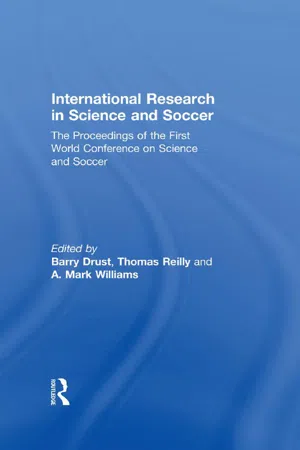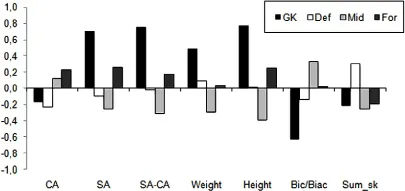CHAPTER ONE
Somatic and maturity status of youth soccer players 11-12 years:
Variation by field position
A. J. Figueiredo1, M. J. Coelho e Silva1 and R. M. Malina2
1Faculty of Sport Science and Physical Education, University of Coimbra, Coimbra, Portugal
2Department of Kinesiology and Health Education, University of Texas, USA
1. INTRODUCTION
Advanced maturation within the same year of birth, during the pre-pubertal and pubertal period, is associated with advantages in body size, percentage of fat-free mass and several functional manifestations such as aerobic performance, strength and velocity (Malina et al., 2004a). Therefore, in sports where the above characteristics are factors that give an advantage in competition, the athletes maturationally more advanced within a chronologically equivalent group are favoured when compared with less developed peers. For example, Helsen et al. (2005) found an effect of the birth month in players selected for advanced training with a bias favouring the older ones (32.6% and 16.0% in the first and last trimesters respectively), in a male sample of Under12 and Under14 soccer players. Furthermore, for the senior English national soccer team, Richardson and Stratton (1999) reported that 50.0% of the participants in the final stage of the 1998 World Cup had been born in the first four official months of competition for youth soccer (between September and December). When the authors analysed the data based on the position of the players in the field, they reported that this discriminating effect was higher for goalkeepers, defenders and forwards than for midfield players.
In a study of 13 to 14-year-old sub-elite soccer players from the north of Portugal, Malina et al. (2004b) reported that midfield players seem to be the lightest and the shortest of all the players, the forwards being heavier and taller. Aziz et al. (2005) and Brocherie et al. (2005) observed the same trend in samples of adult soccer players. Gil et al. (2007) established the anthropometric and physiological profiles of young nonelite soccer players, between 14 and 21 years old, according to their playing position, the goalkeepers being the tallest and heaviest group.
The present study considers somatic and maturity characteristics of youth soccer players aged 11-12 years by field position. Consideration of the anthropometric characteristics in youth soccer, in general, and the playing position, in particular, and their association with maturational evaluation provide a contribution to the literature in this area.
2. METHODS
The sample of the present study comprised 87 male soccer players belonging to the 11 to 12 years old competitive age-group (Table 1). The organization of youth soccer in Portugal uses two-year age groups and all players were born in 1991 or 1992. Players were from 5 teams from the midlands of Portugal that compete at a regional level in a 9-month competitive season (September-May) through the Portuguese Soccer Federation. Players participated in three training sessions per week (each about 90 minutes) and one game per week, usually on Saturday. The study was approved by the Scientific Committee of the University of Coimbra and by each club. The players and their parents provided informed consent. Subjects were informed that participation was voluntary and that they could withdraw from the study at any time.
Height (m), body mass (kg), proportions (bicristal/biacromial ratio - %), adiposity (sum of triceps, subscapular, suprailiac and medial calf skinfolds - mm), skeletal age (SA) (years) evaluated by the FELS method (Roche et al., 1988), chronological age (CA) (years) and the difference between SA and CA (SA minus CA) (years) were used to compare goalkeepers, defenders, midfielders and forwards. In the collection of data, the protocol described in Lohman et al. (1988) was followed. Data were converted to Z-scores and mean Z-scores were compared by position using descriptive statistics.
All data were collected within a two-week period under standard conditions in an indoor facility at the University of Coimbra. The physical measurements were obtained by an experienced researcher in anthropometry.
Table 1. Age (range, mean, standard deviation) and number of players assessed per field position.
3. RESULTS and DISCUSSION
Descriptive statistics by position and results of ANOVA are presented in Table 2. In addition, players were profiled by position using Z-scores (Figure 1). The position related variation was significant for two variables: discrepancy between skeletal age and chronological age (F=2.74, P<0.05, ç2=9%) and height (F=3.67, P<0.02, ç2=12%). Goalkeepers were larger in body size while forwards were taller rather than heavy but both were advanced in skeletal maturation (SA-CA). On the other hand, the midfielders tended to be shorter and lighter and slightly later in skeletal maturation. Besides goalkeepers being younger, they were almost a full standard deviation above their peers, in general, in skeletal maturation and height. The defenders were the fatter and the youngest field-position group. Although speculative, a possible explanation for these results may be differences between central and lateral defenders, the former group being fatter and more mature and the latter group younger and less advanced in maturity.
Table 2. Z-scores of the sample, by field position, for the variables of the study.
Figure 1. Z-score profiling of soccer players by position.
4. CONCLUSION
In this study differences in somatic characteristics and maturation by field position were observed. These results confirm partially the observations by Malina et al. (2004b) and Gil et al. (2007). The former authors also found the lowest values for height and weight in the midfield group while Gil et al. (2007) reported that the goalkeepers were the heaviest and tallest of all the players.
Our results suggest that larger, maturationally advanced players gravitate towards certain positions. Youth coaches tend to use larger, more mature players in positions where larger size is deemed an advantage. So, considering soccer as a sport where physical contact is important, coaches seem to use, in zones of the field near to the goal (and excluding the goalkeepers), the tallest and the heaviest players (defenders and forwards).
This trend for selection of position based on body size at these ages may bias a full development of young players once it is not possible for them to experiment in different positions and, concomitantly, in different tactical behaviours.
References
Aziz, A.R., Tan, F., Yeo, A. and Teh, K.C., 2005, Physiological attributes of professional players in the Singapore soccer league. In Science and Football V, edited by Reilly, T., Cabri, J. and Araújo, D. (London: Routledge), pp. 139-143.
Brocherie, F., Morikawa, T., Hayakawa, N. and Yasumatsu, M., 2005, Pre-season anaerobic performance of elite Japanese soccer players. In Science and Football V, edited by Reilly, T., Cabri, J. and Araújo, D. (London: Routledge), pp. 144-154.
Gil, S.M., Gil, J., Ruiz, F., Irazusta, A. and Irazusta, J., 2007, Physiological and anthropometric characteristics of young soccer players according to their playing positions: relevance for the selection process. Journal of Strength and Conditioning Research, 21, pp. 438-445.
Helsen, W.F., Van Winckel, J. and Williams, A.M., 2005, The relative age effect in youth soccer across Europe. Journal of Sports Sciences, 23, pp. 629-636.
Lohman, T.G., Roche, A.F. and Martorell, R., 1988, Anthropometric Standardization Reference Manual. (Champaign, IL: Human Kinetics).
Malina, R.M., Bouchard, C. and Bar-Or, O., 2004a, Growth, Maturation, and Physical Activity, 2nd ed. (Champaign, Illinois: Human Kinetics).
Malina, R.M., Eisenmann, J.C., Cumming, S.P., Ribeiro, B. and Aroso, J., 2004b, Maturity-associated variation in the growth and functional capacities of youth football (soccer) players 13-15 years. European Journal of Applied Physiology, 91, pp. 555-562.
Richardson, D.J. and Stratton, G., 1999, Preliminary investigation of the seasonal birth distribution of England World Cup campaign players (1982-98). Journal of Sports Sciences, 17, pp. 821-822.
Roche, A., Chumlea, W. and Thissen, D., 1988, Assessing the Skeletal Maturity of the Hand Wrist – FELS Method, (Springfield, Illinois: CC Thomas).
CHAPTER TWO
Physical test performance of elite Portuguese junior soccer players according to positional roles
Á. Ramos, P. Vale, B. Salgado, P. Correia, E. Oliveira, A. Seabra, A. Rebelo and J. Brito
Faculty of Sports, University of Porto, Porto, Portugal
1. INTRODUCTION
Soccer is one of the most popular sports worldwide and a lot of research has been conducted on various aspects of this sport. Most of the relevant studies are based on elite or male participants (Mohr et al., 2005) and there is little research about youth soccer players. With the increasing emphasis on talent development and the minimization of potential injuries among adolescent athletes, there is a consensus between coaches and sport scientists that a comprehensive, sport-specific investigation would aid in more clearly defining present levels of physiological fitness and sports skills specific to youth soccer (Vanderford et al., 2004).
Players must possess moderate to high aerobic and anaerobic power, have good agility, joint flexibility and muscular development, and be capable of generating high torques during fast movements (Reilly et al., 2000). As soccer is a team sport, an efficient organization of the team is required for the optimal development of players’ abilities, the control of opponents, and the successful resolution of a match. Players are placed in certain positions to fulfil specific tasks.
Significant differences in age, stature, body fat and body mass index have been recently identified between elite players of different playing positions suggesting that players with a particular size and shape may be suitable for the demands of the various playing positions (Bloomfield et al., 2005). Positional role appears to have an influence on total energy expenditure in a match, suggesting that different physical, physiological and bioenergetic responses are experienced by players of different positions (Reilly and Thomas, 1976; Di Salvo and Pigozzi, 1998; Stroyer et al., 2004; Pyne et al., 2006; Di Salvo et al., 2007). For example, greatest overall distances appear to be covered by midfield players who act as links between defence and attack (Reilly and Thomas, 1976; Tumilty, 1993; Wisloff et al., 1998; Rienzi et al., 2000; Di Salvo et al., 2007). The best performances in the velocity, agility and power tests were observed in the group of forwards (Tumilty, 1993; Wisloff et al., 1998; Gil et al., 2007).
Therefore, the purpose of the present study was to describe and compare performance in physical tests of youth elite soccer players according to positional roles.
2. METHODS
Eighty-three youth elite soccer players from Portuguese Under-19 first division, practising 4 or 5 times per week (6.92 ± 0.74 hours of training per week) participated in this study. Mean (standard deviation) for age (years), height (m) and body mass (kg) were respectively 18.2 (0.5); 1.760 (0.07); 72.0 (7.2). In accordance with time-motion analysis data of previous studies (Bangsbo et al., 1991; Di Salvo and Pigozzi, 1998) four groups of positional roles were considered, namely full-back (n=13), midfielder (n=37), central defender (n=13) and forward (n=20). Goalkeepers were excluded.
Table 1. Mean values and standard deviations (SD) of age, height (m) and body mass (kg) according to positional roles.
The study was performed during Christmas and New Year holidays to guarantee players were free from school affairs. After a warm-up, all the players performed six physical tests on two occasions interspaced by one week. On day one, the players were evaluated in sprint performance (5 and 30 metres) and agility (T-test). On day two, vertical jump (Squat Jump and Counter-Movement Jump - CMJ) and intermittent exercise performance (Yo-Yo Intermittent Endurance Test -level 2; Yo-Yo IE2) were measured. Photoelectric cells (Speed Trap II – Browser Timing Systems) were used in sprint and agility tests. For vertical jump evaluations an Ergojump device (Digitime 1000, Digitest Finland) was used. The reliability of the physical performance tests was assessed using intraclass correlation coefficients (ICC). The ICC values were 0.98 (Yo-Yo IE2), 0.97 (5 and 30 m...

